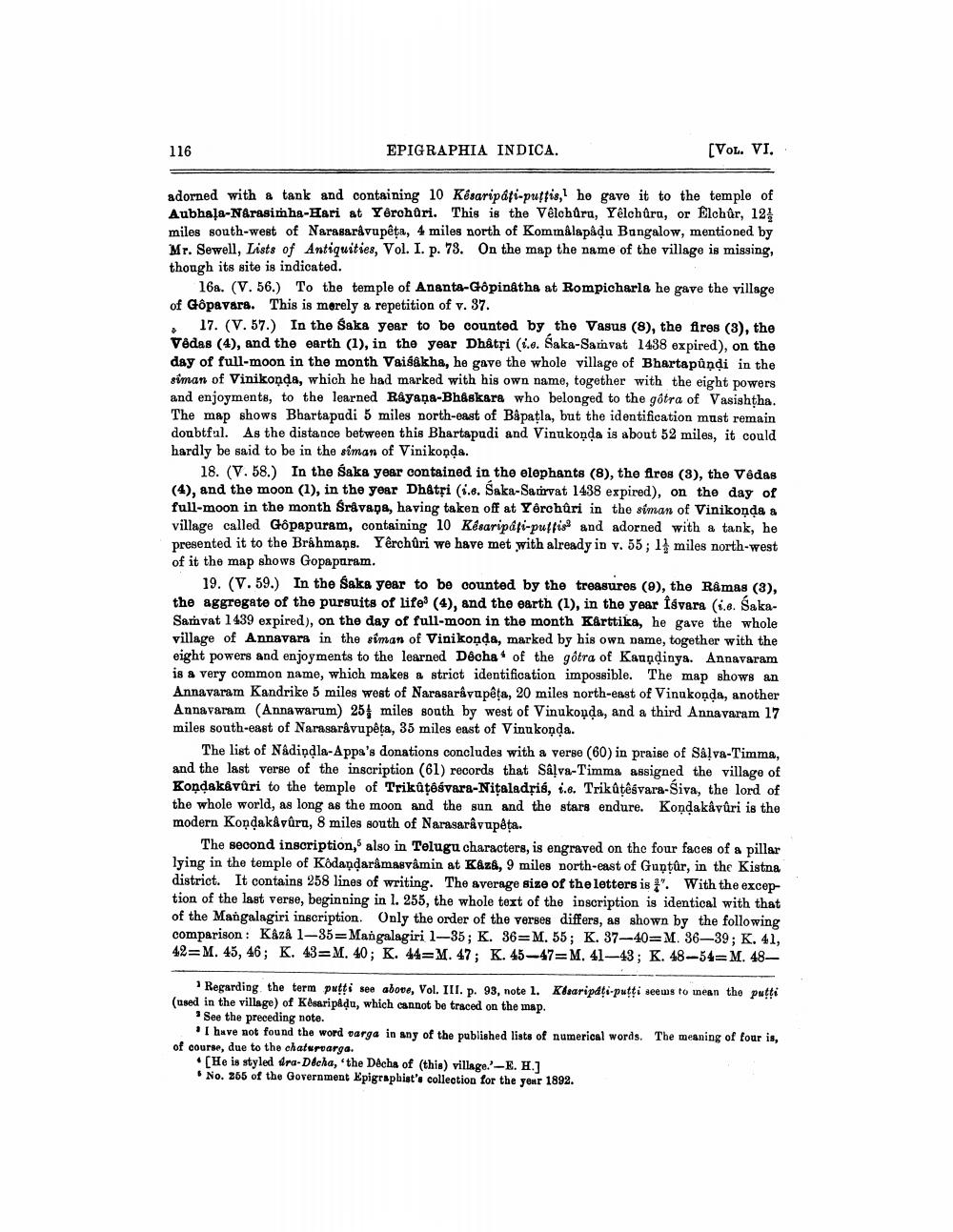________________
116
EPIGRAPHIA INDICA.
[VOL. VI.
adorned with a tank and containing 10 Kesaripati-puffis, he gave it to the temple of Aubhala-Narasimha-Hari at Yerohari. This is the Vêlchůru, Yêlchůru, or Elchûr, 121 miles south-west of Narasarávupêţa, 4 miles north of Kommalapadu Bangalow, mentioned by Mr. Sewell, Lists of Antiquities, Vol. I. p. 73. On the map the name of the village is missing, though its site is indicated.
16a. (V. 56.) To the temple of Ananta-Gôpinátha at Rompicharla he gave the village of Gôpavara. This is merely a repetition of v. 37.
17. (V. 57.) In the Saka yoar to be counted by the Vasus (8), the firos (3), the Vedas (4), and the earth (1), in the year Dhâtpi (.e. Saka-Samvat 1438 expired), on the day of full-moon in the month Vaisakha, he gave the whole village of Bhartapundi in the siman of Vinikonda, which he had marked with his own name, together with the eight powers and enjoyments, to the learned Rayaņa-Bhåskara who belonged to the gôtra of Vasishtha. The map shows Bhartapudi 5 miles north-east of Bapatla, but the identification must remain doubtful. As the distance between this Bhartapadi and Vinukonda is about 52 miles, it could hardly be said to be in the siman of Vinikonda.
18. (V. 58.) In the Saka year contained in the elephants (8), the fires (3), the Vedas (4), and the moon (1), in the year Dh&tsi (s.8. Saka-Satrvat 1438 expired), on the day of full-moon in the month Sravana, having taken off at Yêrchûri in the siman of Vinikonds & village called Gôpapuram, containing 10 Kesarip&fi-puffisa and adorned with a tank, he presented it to the Bráhmang. Yêrchûri we have met with already in v. 55; 1} miles north-west of it the map shows Gopaparam.
19. (V. 59.) In the Saka year to be counted by the treasures (9), the Råmas (3), the aggregate of the pursuits of life: (4), and the earth (1), in the year fávara (.e. SakaSamvat 1439 expired), on the day of full-moon in the month Karttika, he gave the whole village of Annavara in the siman of Vinikonda, marked by his own name, together with the eight powers and enjoyments to the learned Dêcha of the gôtra of Kau dinya. Annavaram is a very common name, which makes a strict identification impossible. The map shows an Annavaram Kandrike 5 miles west of Narasarayapeta, 20 miles north-east of Vinakonda, another Annavaram (Anna warum) 25 miles south by west of Vinukonda, and a third Annavaram 17 miles south-east of Narasarávupêta, 35 miles east of Vinukonda.
The list of Nadindla-Appa's donations concludes with a verse (60) in praise of Salva-Timma, and the last verse of the inscription (61) records that Salva-Timma assigned the village of Kondakâvûri to the temple of Trikûtêsvara-Nitaladfis, 1.6. Trikûtêśvara-Siva, the lord of the whole world, as long as the moon and the sun and the stars endure. Kondakâvûri is the modern Kondakâyüru, 8 miles south of Narasarâvupêta.
The second inscription, also in Telugu characters, is engraved on the four faces of a pillar lying in the temple of Ködaņdarâmasvâmin at Kâzâ, 9 miles north-east of Guntur, in the Kistna district. It contains 258 lines of writing. The average size of the letters is * With the exception of the last verse, beginning in 1. 255, the whole text of the inscription is identical with that of the Mangalagiri inscription. Only the order of the verses differs, as shown by the following comparison : Kaza 1-35=Mangalagiri 1-35; K. 36=M. 55; K. 37-40=M. 36-39; K. 41, 42=M. 45, 46; K. 43=M. 40; K. 44=M. 47; K. 45-47=M. 41-43; K. 48-54= M. 48–
Regarding the term putti see above, Vol. III. p. 93, note 1. Kisaripati-putti seems to inean the putti (used in the village) of Kesaripadu, which cannot be traced on the map.
* See the preceding note.
I have not found the word varga in any of the published lists of numerical words. The meaning of four is, of course, due to the chaturvarga.
• [He is styled dra-Décha, 'the Decha of (this) village.'-E. H.] * No. 265 of the Government Epigraphist's collection for the your 1892.




